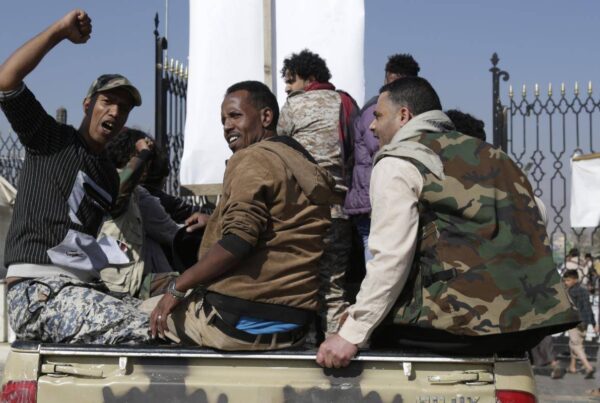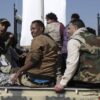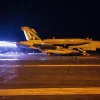The most horrifying week yet of the eight-month uprising in Yemen began on September 18. The terror and fear the people of Sanaa experienced was described by some as the worst since the civil war in 1994, with more than 80 civilians killed and hundreds more injured. In the areas surrounding Change Square — the heart of the protest movement against obstinate President Ali Abdullah Saleh — snipers fanned out on building tops, shooting randomly at sporadic intervals throughout the day and night. Those involved in the protests were shot, as were those who happened to live in the areas nearby. The sound of bombs exploding punctuated the muezzins’ call to prayers in Sanaa mosques, empty as never before. Those who failed to leave before the clashes intensified remained inside their homes for days, trying to survive with whatever supplies they had rather than risk venturing outside.
The clashes started when the protesters tried to enlarge the four-kilometer stretch they have occupied in Sanaa and expand to another nearby street. As protesters began to set up tents, security forces and Republican Guards opened fire. In less than an hour, more than 20 protesters had been killed. Later on, the First Armed Division, a powerful battalion of defected soldiers loyal to the uprising, returned fire. Fighting spread to the Al Hasba neighborhood, the stronghold of the powerful tribal leader Sadeq al-Ahmar. The neighborhood endured heavy clashes between Ahmar and Saleh’s forces only a few months ago; many homes remain abandoned after residents fled.
The tension in Sanaa ratcheted up a notch when Saleh made a sudden surprise return to the country on September 23, after three months in Saudi Arabia recovering from a bomb attack on the presidential palace mosque. Upon the announcement of Saleh’s arrival, celebratory gunfire from his supporters rang out around Sanaa, as demonstrators were being fired upon in Change Square.
Saleh still holds support from several different quarters. He enjoys staunch military backing from the Republican Guards, which are led by his son, and similar support from the security forces led by his nephew, and neither lack firepower, in part due to American contributions intended to fight extremists like Al Qaeda. Then there are the corrupt network of stakeholders who will lose their patronage should Saleh go and the tribes who still support Saleh out of a historical enmity towards the Ahmars. But while pockets of support remain, Saleh’s majority lies in arms, not in popular sentiment. His return was a spark to the powder keg. His stubbornness amidst the chaos was a declaration of war. On September 26, while Yemen was celebrating its 49th anniversary of the 1962 revolution that overthrew the ruling Hamidaddin family, Saleh delivered a speech that for Yemenis contained nothing new. He reiterated his calls for dialogue and for an early presidential election, as he had disingenuously suggested on multiple occasions, while emphasizing that the vice president, not Saleh himself, sign the Gulf Cooperation Council initiative of a transfer of power.
The speech was seen by some as a stall tactic before all-out civil war, but it is not clear what the distinction between war and the current scenario is. It seems the line has already been crossed. Without an intensification of international pressure, particularly from within the GCC (Saudi Arabia’s hospitality and leeway in allowing Saleh to rally his supporters from the kingdom shows the tepid regional pressure on him), Saleh will lead Yemen to hell — indeed, it is already at the gates. But if so baited, the millions of Yemeni youth in the squares who have been demanding change peacefully could erupt like a volcano if their legitimate demands for the immediate departure of Saleh and his regime are not met.
Late last month, while Yemenis on the ground fought for the political future of their country, herds of NGO workers and embassy staff were lining up at Sanaa Airport with the very few Yemenis who can afford to leave the country. Yemen is among the most heavily armed countries on earth, with more than 68 million weapons — almost three arms for every man, woman and child. Yemenis have amazed the world over the last eight months with their peaceful protest. But their patience has run dry.
FAREA AL-MUSLIMI is a Yemeni activist
and writer for Almasdar
This article was published on the Executive
Also, I want to be sure I am correctly understanding https://essay4today.com/ that I do not need to purchase a bar code, only the isbns.







